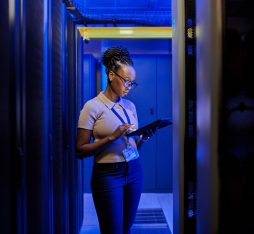“In the future, with 5G and multicast technologies, it will be possible to watch a soccer match in HD quality on your smartphone with no interruptions during a train or car journey.”
Live streaming has become increasingly widespread. With the addition of 5G, this service can be dramatically improved at all levels, including image quality, download times, interruptions and lag. Faced with today’s generations’ enthusiasm for live feeds, researchers are now working to adapt live streaming TV so it can be done on the go.
The Goal: Lag-Free Live Streams
Getting closer to what’s happening live is one of the main challenges in the field of live streaming. Yet, streaming over the Internet using Wi-Fi or 4G still results in a lag of 30, 40 or even 50 seconds on tablets or smartphones. This lag will particularly hit home for any soccer fans who have ever heard their neighbor watching TV and cheering for a goal they haven’t seen yet. It also affects participants in time-limited interactive TV game shows and televised broadcasts by figures of authority in relation to announcements, alerts or disasters, for example. Ensuring service continuity, particularly when faced with high demand, is another challenge of live streaming. At Orange Innovation, researchers are therefore thinking about how they can make improvements in the field of TV streaming on the go, using a combination of 5G, video streaming technologies (multicast, low latency), network bandwidth allocation (network slicing) and edge computing. Their work has primarily focused on mutualizing streams; a key way of saving bandwidth. Dominique Thômé, Product Manager Innovation Data TV, explains that “Unlike unicast technology, which broadcasts streams as many times as there are simultaneous connections, multicast should allow a single stream to be broadcast to thousands of people connected to a large 5G zone. This mutualization prevents bandwidth loss and, consequently, service interruptions from network congestion. Another advantage, which is of great importance to Orange, is that it consumes less energy and therefore contributes to the transition to a low-carbon economy.”
Recognizing the Know-How of Carriers
Experiments carried out in the Orange laboratory have yielded interesting results. A real-time readjustment of video quality to prevent network saturation resulted in each customer being able to watch TV with only five seconds of lag, confirming the feasibility of 5G live streaming on the go. In fact, faced with ever-increasing volumes, some broadcasters are beginning to turn to carriers to broadcast their TV streams. They need players that are able to transmit this huge amount of data while ensuring optimal quality, in order to avoid any latency problems. Thibaut Mathieu, Director of Innovation for Interactive & Multiscreen Services at Orange says that “Our pioneering approach toward 5G live streaming highlights the valuable role that network carriers play, right at the heart of the system, compared to OTT players (“over the top,” such as the Tech Giants), both in terms of technology and business. We will be able to get involved in data transmission, with optimal mutualization technology that will save money and energy.” These technologies are consistent with Orange’s CSR commitment, both in terms of carbon footprint (lower energy consumption) and inclusion (broadcasting the right information at the right time).
More than Just Entertainment
The challenge goes far beyond the traditional TV broadcasting market itself. In the context of the health crisis, brands have been quick to understand the value of live streams to generate sales and are starting to venture into “Live Shopping.” Originating from China, this large-scale approach to teleshopping consists of an online event where presenters, influencers or personalities showcase products live to a digital audience who are able to order products or ask questions. Live Shopping is attracting more and more brands around the world. “With hundreds of thousands of people connected at the same time, its large scale will certainly create capacity issues” says Thômé. “This is another case where mutualization will ensure quality of service.”











